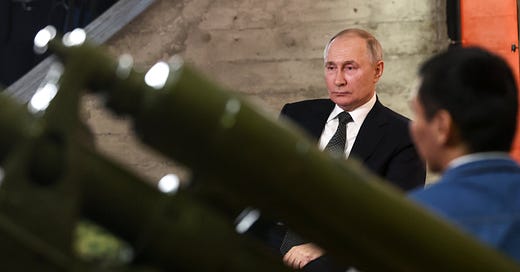RAND report warns of nuclear escalation in Ukraine
Plus: Insidious AI girlfriends, America builds anti-American alliance, Singapore: climate coping capital, America’s most undiplomatic ambassador, NATO chief spouts Putin talking points, and more!
The Ukraine War is now 19 months old, and so far it hasn’t seen either of the two most feared kinds of escalations. The war hasn’t expanded into NATO nations, and it hasn’t gone nuclear. A report released yesterday by the RAND Corporation warns that, though this containment of the war may leave observers “desensitized” to escalatory risks, those risks are real and could lead to a bigger conflagration than is commonly recognized.
The RAND study, based on workshops involving 15 analysts, found “six plausible options for Russian escalation” that could “fundamentally alter the nature of the conflict, ranging from a limited attack on NATO to the use of nuclear weapons against Ukraine.”
And if Russia does go nuclear, the resulting attack could be “surprisingly extensive” because “the Kremlin may assess that the costs and risks it would face from breaking the nuclear taboo would be similar regardless of whether a small or large number of weapons were used… Moscow may decide, therefore, to use whatever number and size of weapons it deems are necessary to achieve its battlefield objectives.”
The most likely trigger for a decision by Russia to escalate, the study found, “is a perception that battlefield losses are threatening the security of its regime.” And the report notes some signs of regime “fragility,” as Putin faces pressure from hardline nationalists who champion maximalist war aims.
Even in the absence of dramatic battlefield setbacks, growing regime insecurity, combined with the prospect of a long, costly, and frustrating war, could make “escalatory options that shorten the conflict more appealing, including potentially nuclear use, even at the risk of possible NATO involvement or loss of support from China.”
The report also notes the possibility of “inadvertent” escalation—triggered by such events as a Russian missile strike killing a NATO-nation official who is visiting Ukraine—and observes that “the longer the conflict drags on, the more such risks will accumulate.”
The RAND report amounts to a kind of reply to hawks, such as Max Boot, who say President Biden shouldn’t worry about crossing Putin’s “red lines”—by, say, giving Ukraine longer-range missiles—because red lines have already been crossed without consequence. One way to put the study’s upshot is this: Though there is no one “red line” that will automatically bring escalation, there are combinations of circumstances that could, in effect, make a given line suddenly red, even if the redness is visible only in retrospect, after the ensuing escalation.
For example: Boot notes that Ukrainian drone strikes on Moscow haven’t led to major escalation, as was once feared. But whether such strikes could prove escalatory depends on various factors—like, whether Russia is facing battlefield setbacks, how restive hardline Russian nationalists are, and what exactly the strikes are striking. The RAND report states: “Should Ukraine expand its attacks on sensitive targets inside Russia, and should those attacks increase in their effectiveness, these factors may increase Russian incentives to also consider more escalatory options given the political risks for the Kremlin of appearing unable to prevent or respond to such attacks…”
Therefore: “US and allied policymakers should carefully evaluate the trade-offs between enhanced support for Ukraine, including the provision of weapons systems with longer ranges, and managing escalation risks, which may become more acute over time… Giving Kyiv the military capabilities to execute long-range strikes against sensitive targets inside Russia likely poses the greatest escalation risks.”
Attention NZN members! This week paid subscribers get the following exclusive content:
The latest edition of Earthling Unplugged, Bob’s conversation with NZN staffer Andrew Day about the items from The Earthling, plus a few stray thoughts.
Early Access to Bob’s conversation with author Sarah Posner. The conversation explored Trump’s electoral chances, whether Democrats should try to shove Biden off the ticket, the state of the religious right, and other topics. The episode will go public next week, though without the Overtime segment that members get access to.
The latest edition of the Parrot Room, Bob’s after-hours conversation with arch-frenemy Mickey Kaus.
As the AI revolution gains momentum, there is growing concern that AIs will replace teachers, radiologists, truckers and… girlfriends. Freya India, in her Substack newsletter Girls, worries that young women will be harmed by the availability of customizable and increasingly realistic AI mates for men.
Already, tech startups like Replika offer a mostly male clientele virtual romantic partners that flirt, send selfies, and show affection. As AI—and VR headsets—improve, these pixelated paramours will be able to do more.
India writes: “Already many girls feel as if they are in constant competition with hyper-sexualized Instagram influencers and infinitely accessible porn stars. Now the next generation will grow up not just with all that but knowing the boys they like can build and sext their ideal woman, and feeling as if they must constantly modify themselves to compete. I find that tragic.”
US foreign policy is increasingly organized around the idea that an axis of anti-western autocracies poses an existential threat to democracy and so must be forcefully opposed. NZN has long warned that this policy can become a self-fulfilling prophecy, as autocracies unite not out of ideological affinity but out of a shared perception of American hostility. Several recent articles illustrate how this dynamic can work:








